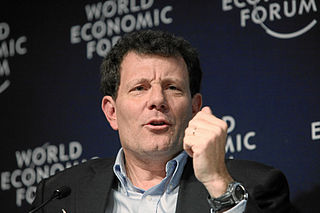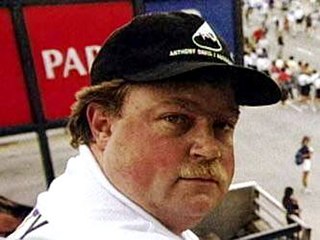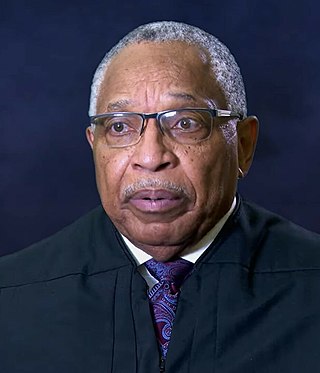
Fort Detrick is a United States Army Futures Command installation located in Frederick, Maryland. Fort Detrick was the center of the U.S. biological weapons program from 1943 to 1969. Since the discontinuation of that program, it has hosted most elements of the United States biological defense program.
Donald Wayne Foster is a retired professor of English at Vassar College in New York. He is known for his work dealing with various issues of Shakespearean authorship through textual analysis. He has also applied these techniques in attempting to uncover mysterious authors of some high-profile contemporary texts. As several of these were in the context of criminal investigations, Foster was sometimes labeled a "forensic linguist". He has been inactive in this arena, however, since Condé Nast settled a defamation lawsuit brought against one of his publications for an undisclosed sum in 2007.
A non-denial denial is a statement that, at first hearing, seems to be a direct, clearcut and unambiguous denial of some allegation or accusation, but after being parsed carefully turns out not to be a denial at all, and is thus not explicitly untruthful if the allegation is in fact correct. It is a case in which words that are literally true are used to convey a false impression; analysis of whether or when such behavior constitutes lying is a long-standing issue in ethics. British newspaper The Sunday Times has defined it as "an on-the-record statement, usually made by a politician, repudiating a journalist's story, but in such a way as to leave open the possibility that it is actually true".

The Lackawanna Six is a group of six Yemeni-American friends who pled guilty to charges of providing material support to al-Qaeda in December 2003, based on their having attended an al-Qaeda training camp in Afghanistan together in the Spring of 2001. The suspects were facing likely convictions with steeper sentences under the "material support law".

Nicholas Donabet Kristof is an American journalist and political commentator. A winner of two Pulitzer Prizes, he is a regular CNN contributor and an op-ed columnist for The New York Times.
"Person of interest" is a term used by law enforcement in the United States, Canada, and other countries when identifying someone possibly involved in a criminal investigation who has not been arrested or formally accused of a crime. It has no legal meaning, but refers to someone in whom the police and/or domestic intelligence services are "interested", either because the person is cooperating with the investigation, may have information that would assist the investigation, or possesses certain characteristics that merit further attention.
Anthrax hoaxes involving the use of white powder or labels to falsely suggest the use of anthrax are frequently reported in the United States and globally. Hoaxes have increased following the 2001 anthrax attacks, after which no genuine anthrax attacks have occurred. The FBI and U.S. postal inspectors have responded to thousands of "white powder events" and targets have included government offices, US embassies, banks and news organizations.

Richard Allensworth Jewell was an American security guard and law enforcement officer who alerted police during the Centennial Olympic Park bombing at the 1996 Summer Olympics in Atlanta, Georgia. He discovered a backpack containing three pipe bombs on the park grounds and helped evacuate the area before the bomb exploded, saving many people from injury or death. For months afterward he was suspected of planting the bomb, resulting in adverse publicity that "came to symbolize the excesses of law enforcement and the news media".

Robert K. "Bob" Stevens was a British-born American photojournalist for the Sun, a subsidiary of American Media, located in Boca Raton, Florida, United States. He was the first journalist killed in the 2001 anthrax attacks when letters containing anthrax were mailed to multiple media outlets in the United States. The anthrax attacks also killed four others in the United States and sickened seventeen others.

The Demon in the Freezer is a 2002 nonfiction book on the biological weapon agents smallpox and anthrax and how the American government develops defensive measures against them. It was written by journalist Richard Preston, also author of the best-selling book The Hot Zone (1994), about ebolavirus outbreaks in Africa and Reston, Virginia and the U.S. government's response to them.

The United States Army Medical Research Institute of Infectious Diseases is the U.S Army's main institution and facility for defensive research into countermeasures against biological warfare. It is located on Fort Detrick, Maryland, near Washington, D.C., and is a subordinate lab of the United States Army Medical Research and Development Command (USAMRDC), headquartered on the same installation.

Reggie Barnett Walton is a senior United States district judge of the United States District Court for the District of Columbia. He is a former presiding judge of the Foreign Intelligence Surveillance Court.

New Jersey in the 21st century has been deeply affected by terrorism and political controversy.
The Anthrax Vaccine Immunization Program (AVIP), is the name of the policy set forth by the U.S. federal government to immunize its military and certain civilian personnel with BioThrax, an anthrax vaccine manufactured by Emergent BioSolutions Inc. It was set up by the Clinton administration.
Mark "Mordechai" Levy is a U.S.-based political activist and founder of the militant Jewish Defense Organization (JDO), a breakaway faction of the Jewish Defense League. David Tell of the Weekly Standard wrote that the group is "located at the farthest, shadowy margins of American public life." Levy has organized a paramilitary training camp located in Upstate New York, named after Revisionist Zionist leader Vladimir Jabotinsky.
Ayaad Assaad is an Egyptian-American microbiologist and toxicologist. He has worked for the US Environmental Protection Agency testing pesticides since 1997.

Bruce Edwards Ivins was an American microbiologist, vaccinologist, senior biodefense researcher at the United States Army Medical Research Institute of Infectious Diseases (USAMRIID), Fort Detrick, Maryland, and the person suspected by the FBI of the 2001 anthrax attacks. Ivins died on July 29, 2008, of an overdose of acetaminophen (Tylenol/paracetamol) in a suicide after learning that criminal charges were likely to be filed against him by the Federal Bureau of Investigation (FBI) for an alleged criminal connection to the attacks.

The 2001 anthrax attacks, also known as Amerithrax, occurred in the United States over the course of several weeks beginning on September 18, 2001, one week after the September 11 terrorist attacks. Letters containing anthrax spores were mailed to several news media offices and to Senators Tom Daschle and Patrick Leahy, killing five people and infecting 17 others. Capitol Police Officers and staffers working for Senator Russ Feingold were exposed as well. According to the FBI, the ensuing investigation became "one of the largest and most complex in the history of law enforcement".
David Freed is an American author, educator, journalist and screenwriter. Freed has written on criminal justice issues for Los Angeles Times. Freed shared the 1993 Pulitzer Prize for Spot News Reporting with fellow writers at the newspaper for reportage on the Rodney King riots in 1992.

Carter William Page is an American petroleum industry consultant and a former foreign-policy adviser to Donald Trump during his 2016 presidential election campaign. Page is the founder and managing partner of Global Energy Capital, a one-man investment fund and consulting firm specializing in the Russian and Central Asian oil and gas business.











